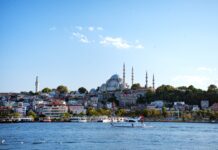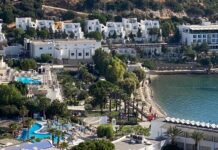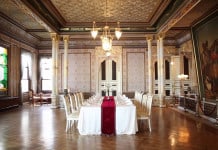
It’s the first night in Istanbul and we’re eating like kings—which is fitting since the recipes all stem from Ottoman Palace cuisine dating back 500 years. Plates of stuffed quince and chicken bourek come one after another filling the table at Asitane, a restaurant positioned near a former Byzantine-era church overlooking the Golden Horn. Part of what makes this cuisine so special is the attention to detail, researched heavily by a team of food historians studying the ancient kitchens of the Topkapi, Edirne and Dolmabahçe palaces, who then recreate it in a modern way. Twists on tradition are what make Istanbul such an attractive city—classic institutions are turned into something contemporary, so everything from a former palace to bank are now a hammam or hotel.
“Combined with Istanbul’s historic venues, palaces, museums, bazaars, cisterns, design venues and more, [the city] offers meeting planners a variety of remarkable options to create truly outstanding events,” explains Istanbul Convention & Visitors Bureau’s general manager, Özgül Özkan Yavuz. “Istanbul is also one of the world’s top food destinations with eateries offering fabulous quality traditional fare, haute cuisine and fusion, many in [iconic] locations such as being perched on the Bosphorus with views across the historic peninsula and beyond.”
Istanbul: Cornerstone of Turkish Culture
We quickly learn that food is a cornerstone of Turkish culture, and it’s almost impolite to refuse a dish or Turkish coffee at a meeting—not that we’d want to. At PeyDerPey, tucked in the Beyoglu area on the famous Istiklal walking street next to chain stores, kebap shops and modern art galleries, Turkish Chef Vedat Basaran is a master at recreating forgotten Ottoman dishes by putting his own gourmet spin on cookbook classics. Panoramic windows on the sixth floor also serve up stunning views of the old city, putting the glittering Bosphorus Strait on display.
In Istanbul, groups can wine and dine in a number of other ways, from Turkish wine tastings overlooking Istiklal Street to dining on the water in the floating island venue Suada Club. Our group hopped on a mini cruise of the Bosporus on our way to this super chic club, which straddles the border between Asia and Europe. The island can host up to 700 banquet-style, 1,500 al fresco or in a ballroom that opens to the stars. Groups that don’t want the party to end can take a boat to Suada’s sister club, Reina, located on shore.
Modern-day Historic Hotels
Istanbul’s up-and-coming neighborhood Karaköy in the northern part of the Golden Horn was once home to banks and electrical shops, and groups can still see evidence of these landmarks today. The new 63-room Vault Karaköy, The House Hotel is perched on the Avenue of Banks just next to the former Imperial Ottoman Bank. Set in a 19th century bank, most of the original structures—like the bank vaults—are still standing. Down below, one of the meeting rooms features one of these original bank vaults.
Just across the street, another new hotel that pairs with Vault Karaköy to host groups is design genius Ian Schrager’s 71-room 10 Karaköy, A Morgans Original, which opened following renovations in 2014. The original building was used as a hospital for over 350 years and was rebuilt in 1875 and given the nickname “Fishy Inn.” Generations of Turks still know the structure under this name, even though it opened as a shopping center with electrical stores in the 1950s. Now the building is home to the only hotel chain in Karaköy. “It’s good for Istanbul having the Morgans Group. Anyone living in Istanbul knows this building and its history,” explains Engin Tinmaz, 10 Karaköy’s sales and marketing manager. “The location is also fantastic; this is the middle of the city with the Old City on the left side and Taksim just up the hill.”
The six-floor building is topped off by a glass atrium that opens into a Sky Terrace, giving groups of up to 90 a panoramic view over the city in a setting that resembles Studio 54. For a more intimate affair, the 31-foot-long chefs table seats up to 38 guests in a cave-like setting with Mediterranean fare whipped up by the hotel’s award-winning Chef Rudolf Van Nunen.”The special thing about this space is that when we change courses during the meal, the lighting and music changes,” Tinmaz says. So when guests are eating fish, the surrounding will follow suit, with blue lighting and ocean music playing in the background.
Fourth-Century Meeting Venues
Groups don’t even need to plan for sightseeing in Istanbul—they can attend events right in the sites themselves. The 336-column Basilica Cistern, one of the oldest water reservoirs in the world dating back to the 4th century, is just one example. The former Eastern Orthodox church, Hagia Irene, the first built in Constantinople, can also be used as a concert venue.
The 17th century Blue Mosque in the Old City of Sultanahmet, whose nickname reflects the 20,000 blue ceramic tiles that line its interior, have helped make the spot a must for groups. The maze-like Grand Bazaar, one of the largest covered markets in the world, is another worth visiting, with 5,000 shops selling rugs, jewelry and lamps lining 60 streets. While groups are in the area, they can even take home a bit of the culinary culture with a candy cooking demo at NAR Restaurant, featuring methods inspired by the original process dating back to the 17th century.
“The natural beauty of the city, its exciting scene blending a metropolitan way of life, and its modern infrastructure makes it a unique meeting place for businesses,” Yavuz says. “A magnet for dynamic and talented people from around the world, Istanbul is the ideal MICE destination with its vibrancy, modernity, swathe of new infrastructure, heritage and enviable geographical position.”–Lane Nieset







